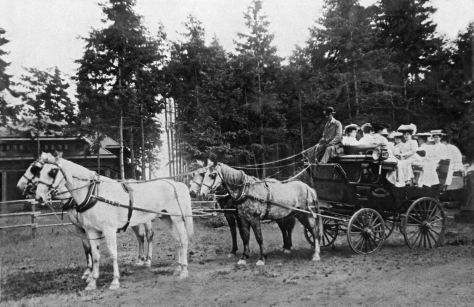(click to enlarge photos)


The well-connected Gladys Barnette and William Bernard started their thirty-two years of married life in the Olympia mansion of Washington state’s first governor, Elisha Ferry. That is, they were married there in 1892. About ten years later the Seattle couple began spending part of their summers on Alki Point, when it still took a steamer or a ferry ride followed by a long walk to get there. The first Midwestern farmers had landed there fifty years earlier, with enterprising intentions of building a city, although they soon fled Alki Point for Piners Point, known now as the Pioneer Square Historic District.


When first vacationing on the Point, the Bernards rented one of the well-wrought and framed tents and furnished it first with Persian rugs spread on a carpentered frame. They soon bought the block extending south from Alki Beach along the west side of Southwest 61st Street and hired Seattle architect Fred Fehren to design for them a rustic and yet baronial log lodge. The couple who founded the Seattle Soap Company, the city’s first, was skilled at both real estate and manufacturing. The Bernards could afford their new Alki home, which they named Fir Lodge.



Built in 1903-04, the lodge was one of the two largest structures on the then still sparsely settled Point. The other, the nearby Stockade Hotel and chicken dinner resort, was built by their friends, Alfred and Lorena Smith. It also was constructed of logs “harvested” off the Point, and both of these Arcadian creations had oversized fireplaces built of beach stones. The Bermards bought their block from the Smiths, because Lorena’s parents, the Hansons, had purchased the entire Alki Point in the late 1860s from Doc Maynard, one of Seattle’s original pioneers. This was, and is, historic ground.

For reasons that are still a mystery to Alki Point historians, the Bernards, after three years of hosting well-appointed parties on the open veranda of their log palace, sold it in 1907 to the then fledgling Seattle Auto Club. After the motorists decamped from the Point in 1911, the lodge served as a residence. In 1950 it opened as a restaurant, the Alki Homestead, which brings us to its scorching and closure in 2009. (See the Log Cabin Museum links on all that, which Jean has attached below.)



This year Jean and I enjoyed the Southwest Seattle Historical Society’s 4th of July picnic on the patio beside the Society’s Log House Museum, a restored Carriage House that was part of the Bernards’ estate. Following the potluck, Clay Eals, the spirited executive director of the Society, led us into the damaged Homestead. He had the key and a light heart, too. After the fire the Homestead was left haunted for six-plus years by fears that the log landmark might be razed. Instead, it has been saved, and its new hands-on owner Dennis Schilling has begun the restoration. Now the Society has named its upcoming November 7th Gala, “Coming Home to Homestead.”



WEB EXTRAS
Let me throw in a handful of photos that illustrate a few of our previous run-ins with Mr. Eals and his SW Seattle preservationists.





Anything to add, kids?
YUP and sticking to form, Ron Edge starts off with a few not-so-old features that are relevant to the Homestead and-or Alki. [Now Jean, Ron calls to explain that his home sitting high on a knoll overlooking Lake Washington has been a victim of today’s (Saturday morning) storm. So he is waiting for the electricity service to return, but has also learned that it will probably not be until 3 a.m. Sunday morning that he should hope for it. And so we will wait too on our Edge Links. WHEN THEY COME he will position them at the very bottom.
This is the third time was have touched on that landmark for a story, although the first use was long enough ago that we have scaned the clipping and attach it just above. There were five or more glossies of the Homestead from which that one was chosen. Once the Edge Links are up you will find many of the others by exploring their fea tures. Ron is also including at the bottom of this week’s eight chosen links a feature titled “Travels with Jean,” which will, we hope, inspire Jean to share some of the photographs he took on his recent visit to Europe with a cadre of about twenty of his students at HILLSIDE SCHOOL (See the “button” link above right for more on the Bellevue School where Jean teaches.) Berangere Lomont, who is, we hope you know, one of the principals behind this blog, helped out in France. And Jean has responded!!! And here, next, is BB.
Jean here. Let me hasten to add a couple of photos I took a couple weeks ago featuring our remarkable blog partner Berangere Lomont:


=====
FOUR TIMES CLIPPINGS of the BERNARDS’ TWO DAUGHTERS. First on with a fashionable sketch of their oldest, Marie (the concertizing pianist), followed by three of Billie, their youngest. (Billie was one of Ivar Haglund’s friends. He used to pick her up in his Ford convertible with a heated brick on the floor board to warm her feet.)




======
HERE FOLLOWS THOSE EDGE LINKS – WHEN THE POWER LINES ARE REPAIRED



























